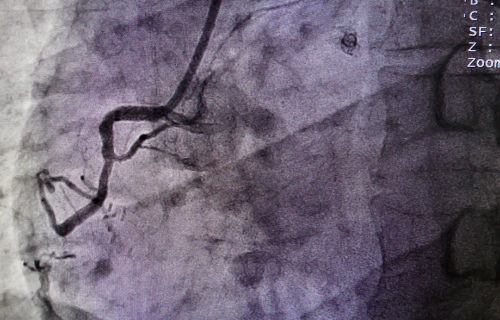Difference Between Pericarditis and STEMI
Both pericarditis and ST-elevation myocardial infarction (STEMI) involve chest pain, palpitations, and shortness of breath. Pericarditis is the inflammation of the pericardium while STEMI is a very dangerous type of heart attack where a major artery is completely blocked. The following discussions further delve into their differences.

What is Pericarditis?
Pericarditis came from the Greek prefix “peri-” which means “surrounding”; from the Greek word “kardia” meaning “heart”; and the Latin suffix “-itis” denoting “inflammation”. It is also known as pericardial disease and it occurs when there is inflammation of any of the layers of the thin fluid-filled sac surrounding the heart, the pericardium (Beckerman, 2020).
Symptoms:
Most of the patients with pericarditis experience sharp, piercing pain in the left side or center of the chest. The other symptoms include low fever, heart palpitations, nausea, fatigue, shortness of breath, dry cough, and swelling of the legs or abdomen (Health Direct, 2021).
Causes:
Viral infection (i.e., respiratory infection) is one of the common reasons of pericarditis. Recurring pericarditis may be due to autoimmune disorders such as lupus, scleroderma, and rheumatoid arthritis. Other causes may include cancer, heart surgery, heart attack, kidney failure, AIDS, and side effects of medications such as phenytoin and warfarin (American Heart Association, 2021).
Treatment:
A number of patients with pericarditis recover in around two to four weeks (Beckerman, 2020). The treatments include avoiding strenuous activities, antibiotics, NSAIDs, pain relievers, anti-inflammatory medications, and surgery (American Heart Association, 2021).

What is STEMI?
STEMI, also known as “widowmaker heart attack”, is a very dangerous type of heart attack where a major artery is completely blocked; it is usually associated with coronary artery disease (Akbar, et al., 2021). The ST segment pertains to the flat section of an electrocardiogram (Fogoros, 2021).
Signs and Symptoms
The signs and symptoms for STEMI include chest pain or discomfort, dizziness, nausea, shortness of breath, sweatiness, palpitations, and anxiety (ECG Medical Training, 2022).
Causes/ Risk Factors
The causes of STEMI include buildup of plaque on artery walls, drug use (i.e., cocaine and alcohol), smoking, high levels of cholesterol and/or blood pressure, obesity, diabetes, overexertion, and stress. The risk factors include age (men over 50 years old with a family history of heart disease and women after menopause ends), and untreated infections such as syphilis and salmonella (Baptist Health, 2022).
Treatment
The treatment for STEMI must be started as soon as possible. Drugs such as beta-blockers and statin are administered to stabilize the heart muscle and efforts are done to reopen the blocked artery. It is crucial for the artery to be opened within 3 hours of the blockage to prevent permanent damage. The longer it takes for the artery to be unblocked, the more damage there will likely be. The approaches utilized in reopening arterial obstruction are thrombolytic therapy (involves clot-busting medications), angioplasty (surgical reopening of artery), and stenting (insertion of a mesh tube). The acute phase of treatment is followed by an extensive recovery period which involves dietary changes, exercise program, and medications for lipid control and anticoagulation (Fogoros, 2021).
Difference between Pericarditis and Pericardial Effusion
Definition
Pericarditis occurs when there is inflammation of any of the layers of the thin fluid-filled sac surrounding the heart, the pericardium (Beckerman, 2020). In comparison, STEMI, also known as “widowmaker heart attack”, is a very dangerous type of heart attack where a major artery is completely blocked; it is usually associated with coronary artery disease (Akbar, et al., 2021).
Symptoms
Most of the patients with pericarditis experience sharp, piercing pain in the left side or center of the chest. The other symptoms include low fever, heart palpitations, nausea, fatigue, shortness of breath, dry cough, and swelling of the legs or abdomen (Health Direct, 2021). As for STEMI, the signs and symptoms include chest pain or discomfort, dizziness, nausea, shortness of breath, sweatiness, palpitations, and anxiety (ECG Medical Training, 2022).
Causes
Viral infection (i.e., respiratory infection) is one of the common reasons of pericarditis. Recurring pericarditis may be due to autoimmune disorders such as lupus, scleroderma, and rheumatoid arthritis. Other causes may include cancer, heart surgery, heart attack, kidney failure, AIDS, and side effects of medications such as phenytoin and warfarin (American Heart Association, 2021). On the other hand, the causes of STEMI include buildup of plaque on artery walls, drug use (i.e., cocaine and alcohol), smoking, high levels of cholesterol and/or blood pressure, obesity, diabetes, overexertion, and stress (Baptist Health, 2022).
Treatment
The treatments for pericarditis include avoiding strenuous activities, taking antibiotics, NSAIDs, pain relievers, anti-inflammatory medications, and undergoing surgery (American Heart Association, 2021). Regarding STEMI, the approaches utilized in reopening arterial obstruction are thrombolytic therapy (involves clot-busting medications), angioplasty (surgical reopening of artery), and stenting (insertion of a mesh tube). The acute phase of treatment is followed by an extensive recovery period which involves dietary changes, exercise program, and medications for lipid control and anticoagulation (Fogoros, 2021).
Pericarditis vs STEMI

Frequently Asked Questions (FAQs):
Why does pericarditis cause ST elevation?
It is thought that the local inflammatory change in the epicardium is the source of the ST elevation (Teh, et al., 1993).
Does pericarditis have ST elevation?
Pericarditis can cause ST elevation (Burns & Buttner, 2021).
How do you know if you have pericarditis on ECG?
Regarding pericarditis, typical ECG findings include diffuse concave-upward ST-segment elevation and, sometimes, PR-segment depression (Marinella, 1998).
Are there always ECG changes with pericarditis?
The ECG may be normal in the early stages (Wedro, 2021).
Summary
- Pericarditis is the inflammation of the pericardium while STEMI is a very dangerous type of heart attack where a major artery is completely blocked.
- Most of the patients with pericarditis experience sharp, piercing pain in the left side or center of the chest.
- STEMI’s signs and symptoms include chest pain or discomfort, dizziness, nausea, shortness of breath, sweatiness, palpitations, and anxiety.
- Difference Between Hematoma and Melanoma - February 9, 2023
- Difference Between Bruising and Necrosis - February 8, 2023
- Difference Between Brain Hematoma and Brain Hemorrhage - February 8, 2023
Search DifferenceBetween.net :
Leave a Response
References :
[0]Akbar, H., Foth, C., Kahloon, R., & Mountfort, S. (2021). Acute ST elevation myocardial infarction. NCBI. https://www.ncbi.nlm.nih.gov/books/NBK532281/
[1]American Heart Association (2021). What is pericarditis. https://www.heart.org/en/health-topics/pericarditis/what-is-pericarditis
[2]Baptist Health (2022). STEMI myocardial infarction. https://www.baptisthealth.com/services/heart-care/conditions/stemi-myocardial-infarction
[3]Beckerman, J. (2020). Heart disease and pericarditis. WebMD. https://www.webmd.com/heart-disease/guide/heart-disease-pericardial-disease-percarditis
[4]Burns, E. & Buttner, R. (2021). Pericarditis. Life in the Fast Lane. https://litfl.com/pericarditis-ecg-library/
[5]ECG Medical Training. (2022). What is a STEMI? https://www.ecgmedicaltraining.com/what-is-a-stemi/
[6]Fogoros, R. (2021). ST-Segment elevation myocardial infarction. Very Well Health. https://www.verywellhealth.com/stemi-st-segment-elevation-myocardial-infarction-1746032
[7]Health Direct (2021). Pericarditis. https://www.healthdirect.gov.au/pericarditis
[8]Marinella, M. (1998). Electrocardiographic manifestations and differential diagnosis of acute pericarditis. American Family Physician. https://www.aafp.org/afp/1998/0215/p699.html
[9]Teh, B.S., Walsh, J., Bell, A.J., Walker, S.J., & Kilpatrick, D. (1993). Electrical current paths in acute pericarditis. PubMed. https://pubmed.ncbi.nlm.nih.gov/8228718/
[10]UpToDate (2022). Patient education: Pericarditis (Beyond the Basics). https://www.uptodate.com/contents/pericarditis-beyond-the-basics
[11]Wedro, B. (2021). Pericarditis. MedicineNet. https://www.medicinenet.com/pericarditis/article.htm
